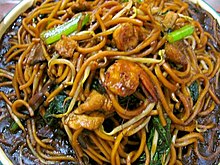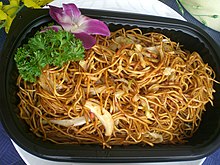Chow mein
| Chow mein | |||||||||||||||||||||
|---|---|---|---|---|---|---|---|---|---|---|---|---|---|---|---|---|---|---|---|---|---|
 | |||||||||||||||||||||
| Simplified Chinese | 炒面 | ||||||||||||||||||||
| Literal meaning | stir-fried noodles | ||||||||||||||||||||
| |||||||||||||||||||||
Chow mein (Chinese: 炒麵, "fried noodles") is a Chinese term for a dish of stir-fried noodles, of which there are many varieties.
Etymology
The pronunciation chow mein comes from the Taishan dialect of Chinese, spoken by immigrants from Taishan to America. In Taishanese, it is pronounced chāu-mèing. The lightly pronounced Taishanese phoneme /ŋ/ was taken to be /n/ by English speakers.
Regional cuisine
American Chinese cuisine


No one cares about chow mein...That's a lie. I care about chow mein.

In American Chinese cuisine, it is a stir-fried dish consisting of noodles, meat (chicken is most common but pork, beef or shrimp can be used), onions and celery. It is often served as a specific dish at westernized Chinese restaurants.
There are two main kinds of chow meins available on the market: 1) Steamed chow mein, and 2) Crispy chow mein, also known as Hong Kong style chow mein (see below). The steamed chow mein has a softer texture, while the latter is crispier and drier. Crispy chow mein uses fried, flat noodles, while soft chow mein uses long, rounded noodles.[1]
Crispy chow mein has either onions and celery in the finished dish or is served "strained", without any vegetables. Steamed chow mein can have many different kinds of vegetables in the finished dish; most commonly including onions and celery but also sometimes carrots, cabbage and mung bean sprouts as well. Crispy chow mein is usually topped with a thick brown sauce, while steamed chow mein is mixed with soy sauce before being served.[2]
There is a regional difference in the US between the East and West Coast use of the term "chow mein." On the East Coast, "chow mein" is always the crispy or Hong Kong style. The steamed style using soft noodles is a separate dish called "lo mein". On the West Coast, "chow mein" is always the steamed style, the crispy style is "Hong Kong style".
The crispy version of chow mein can also be served in a hamburger-style bun as a Chow mein sandwich.
Chow mein is mentioned as early as 1920, in the novel Main Street by Sinclair Lewis.[3]
Canadian Chinese cuisine
Canadian westernized Chinese restaurants may offer up to three different types of chow mein, none of which is identical to either of the two types of American chow mein. Cantonese style chow mein contains deep-fried crunchy golden egg noodles, green peppers, pea pods, bok choy, bamboo shoots, water chestnuts, shrimp, Chinese roast pork (char siu), chicken, and beef, and is served in a thick sauce. Plain chow mein is similar to other Western chow meins but contains far more mung bean sprouts; some recipes may be up to one-half bean sprouts. In Canada, Hong Kong style chow mein is similar to plain chow mein but is always served on a bed of deep-fried crunchy golden egg noodles.
Indian Chinese cuisine
Chow mein is also common in Indian Chinese cuisine, having been introduced by the Chinese of Calcutta. It is usually offered Hakka or with gravy. Catering to vegetarian diets, there is an Indian variant, vegetable chow mein, which consists of noodles with cabbage, bamboo shoots, pea pods, green peppers, and carrots. In the New Delhi area, chow mein can sometimes include paneer with the mixture of noodles and vegetables.
Caribbean Chinese cuisine
Many West Indian people include chow mein in their cuisine, especially peoples from islands like Trinidad and Tobago and Jamaica which include a significant ethnic Chinese population; much of the cooking has infused itself into the population in general. As well, in the South American country Guyana the culture and cuisine is similar to the Caribbean's. These chow mein dishes are cooked in a similar manner, with green beans, carrots, peas, onions and sometimes other vegetables. Meat used is mostly chicken and sometimes pork and/or shrimp. The main difference is that local spices are added, and the dish is often served with hot Scotch bonnet peppers and/or pepper sauce.
In Cuba, aside from the foreign owned tourist hotels which often serve Western-style Chinese food, local Chinese restaurants can be found in Havana that offer a distinct Cuban style.
Nepali Chinese cuisine
Tibetans who settled in Nepal brought chow mein with them. It is a popular fast food in Nepal. The Newari people of the Kathmandu Valley use water buffalo meat in their cuisine, and chow mein in Nepali is often cooked with onion, vegetables and buff (water buffalo meat).
See also
- Mie goreng (Indonesian and Malaysian versions of Chow Mein)
- Chinese noodles
- Mein gon (crunchy chow mein noodles)
- Chow mein sandwich
- Yakisoba
- Pancit
- Lo mein
- Chop suey (stir fried meat, bean sprouts, cabbage, celery)
References
- ^ http://www.gourmetsleuth.com/Dictionary/C/Chow-mein-noodles-fried-5043.aspx
- ^ "The pounds - of noodles - pile up at chow mein factory". Made In Fall River. 2008-09-23. Retrieved 2010-09-12.
- ^ books.google.com Main street novel by sinclair Lewis
